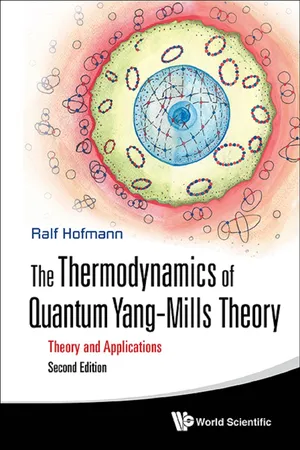
- 580 pages
- English
- ePUB (mobile friendly)
- Available on iOS & Android
About this book
This latest edition enhances the material of the first edition with a derivation of the value of the action for each of the Harrington–Shepard calorons/anticalorons that are relevant for the emergence of the thermal ground state. Also included are discussions of the caloron center versus its periphery, the role of the thermal ground state in U(1) wave propagation, photonic particle–wave duality, and calculational intricacies and book-keeping related to one-loop scattering of massless modes in the deconfining phase of an SU(2) Yang–Mills theory. Moreover, a derivation of the temperature–redshift relation of the CMB in deconfining SU(2) Yang–Mills thermodynamics and its application to explaining an apparent early re-ionization of the Universe are given. Finally, a mechanism of mass generation for cosmic neutrinos is proposed.Advanced students, postdocs and researchers in theoretical physics and mathematics, as well as experimentalists.Selfdual Field Configurations; Calorons; Thermal Ground State; Inert Adjoint Scalar Field; Caloron Overlap; Effective Coupling; Attractor Solution; Quantum of Action; Electric-Magnetically Dual Interpretation; Unitary-Coulomb Gauge; Mandelstam Variables; Constraints; Radiative Corrections; Caloron Center; Caloron Periphery; Wave Propagation; Photons; Monopole Condensate; Preconfining Phase; Center-Vortex Loops; Hagedorn Transition; Polarization Tensor; Black-Body Anomaly; Cosmic Microwave Background (CMB); Unexplained Extragalactic Emission; Planck-Scale Axion; CMB Temperature-Redshift Relation; Cosmic Neutrinos Key Features:This is the first research book of its kind with essentially nonperturbative and analytical approach to Yang–Mills thermodynamicsAn overview on relevant topological field configurations and interconnection between deep theory and physical predictions in the realm of low-temperature photon gases
Frequently asked questions
- Essential is ideal for learners and professionals who enjoy exploring a wide range of subjects. Access the Essential Library with 800,000+ trusted titles and best-sellers across business, personal growth, and the humanities. Includes unlimited reading time and Standard Read Aloud voice.
- Complete: Perfect for advanced learners and researchers needing full, unrestricted access. Unlock 1.4M+ books across hundreds of subjects, including academic and specialized titles. The Complete Plan also includes advanced features like Premium Read Aloud and Research Assistant.
Please note we cannot support devices running on iOS 13 and Android 7 or earlier. Learn more about using the app.
Information
PART 1
Theory
Chapter 1
The Classical Yang–Mills Action
1.1 Historical Remarks





Table of contents
- Cover
- Halftitle
- Title
- Copyright
- Dedication
- Preface of Second Edition
- Preface of First Edition
- Contents
- Part 1 Theory
- Part 2 Applications
- Acknowledgments
- Author Index
- Subject Index